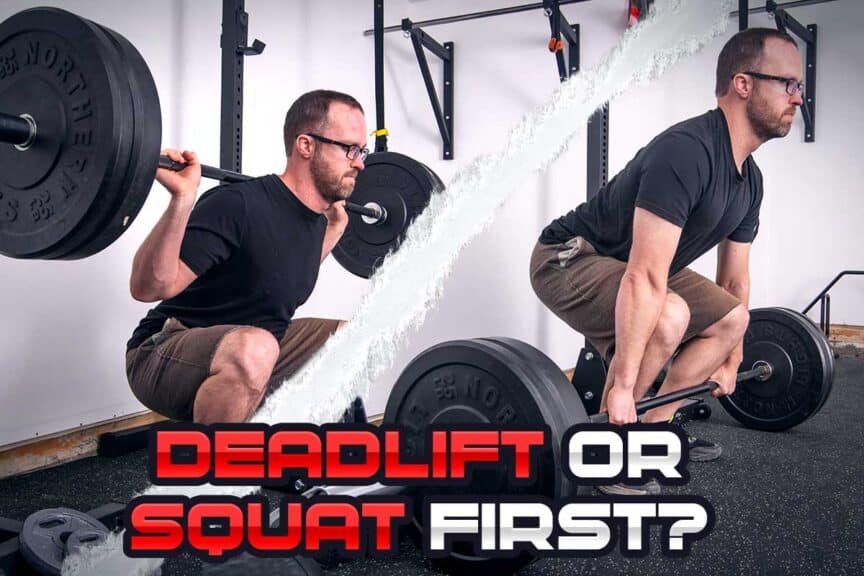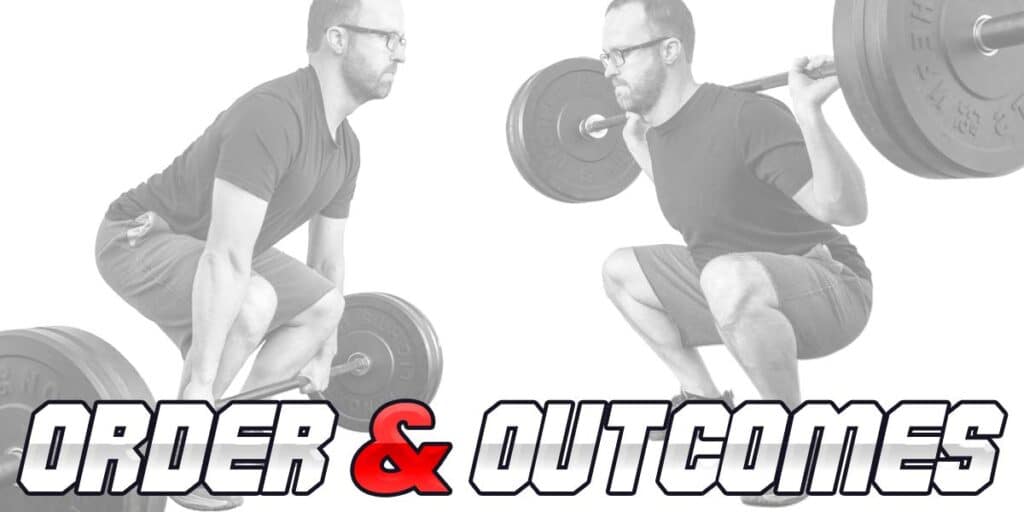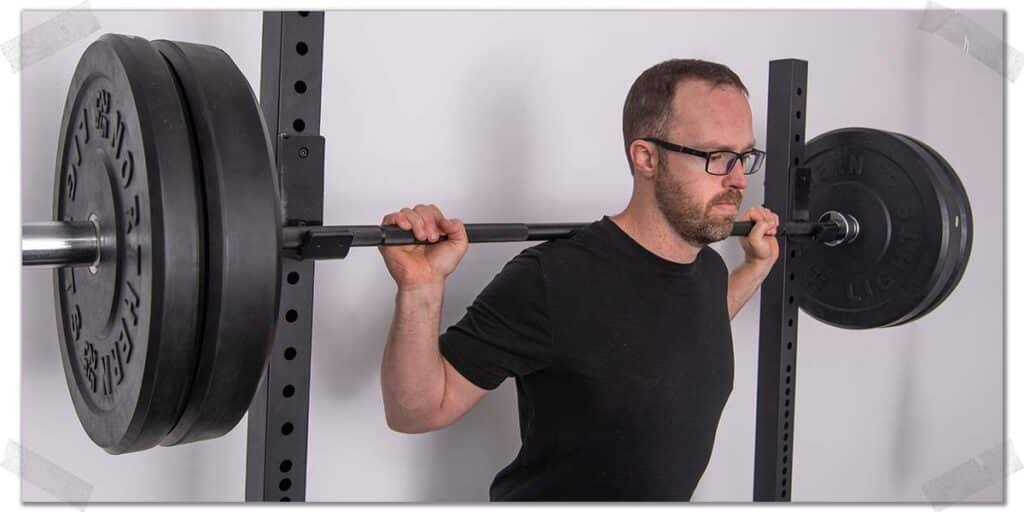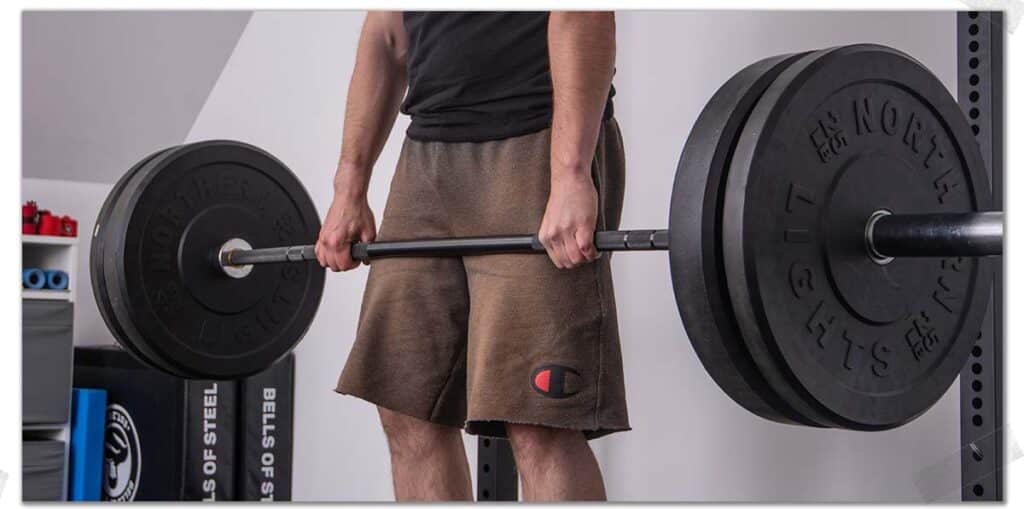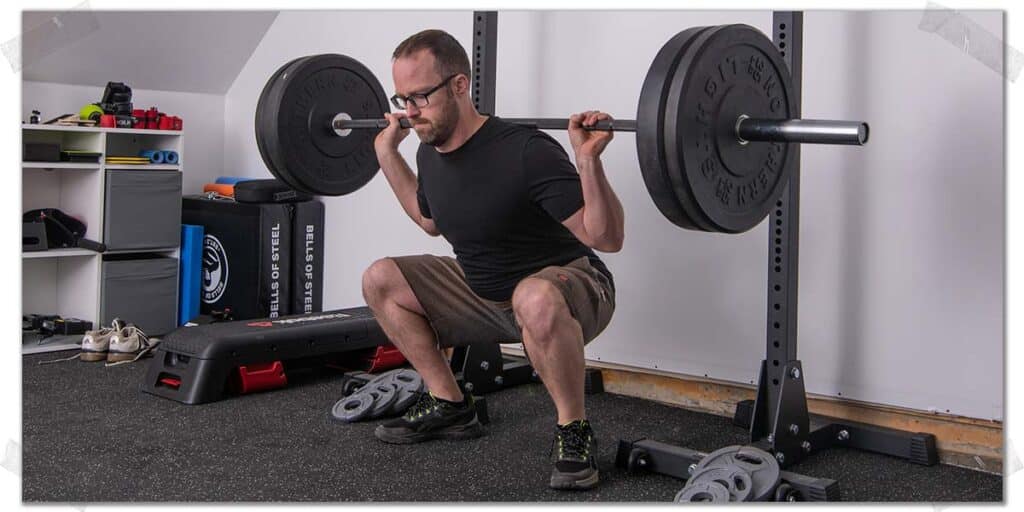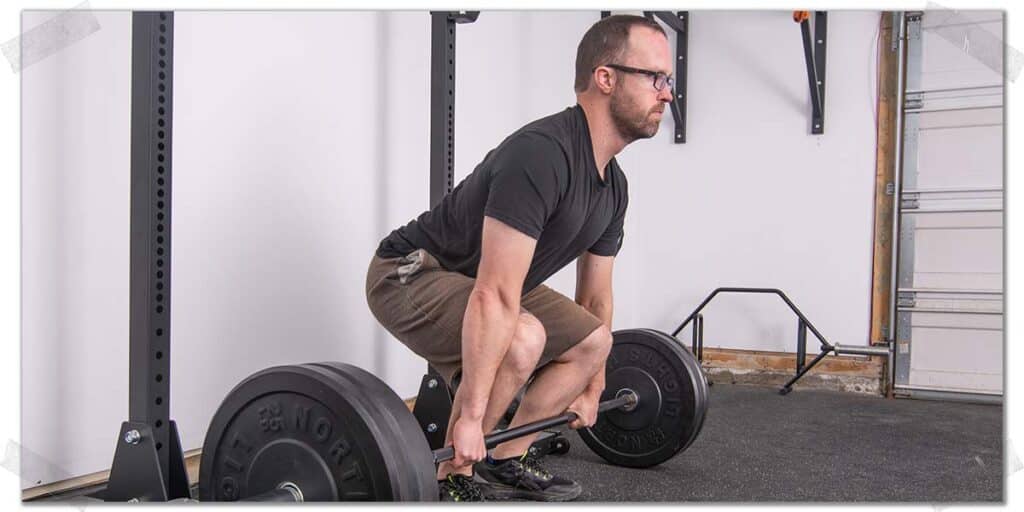It’s a question that plenty of lifters and active individuals ask at some point in their training career: is it better to deadlift or squat first when working out? To be clear, it’s a brilliant question for any athlete or individual to ask since it signifies that they’re looking to get the most out of their training. So, kudos to you if you have the same question.
And when it comes to answers, you’re in the right spot; this article will walk you through the various factors and considerations that must be weighed to help you pick which exercise should be done first in your workout.
So, what’s the answer? Here’s the Reader’s Digest version below:
Deadlifting or squatting first in a workout depends on multiple factors, including training goals, individual needs, training experience, your squat and deadlift parameters, and more. Each lifter should strive to pick their ideal order based on these factors since there is no universal right answer.
Now, if you want to know how to weigh these factors and how to have supreme confidence in picking the ideal order for these exercises, I will break everything down in detail below. So, let’s get to it!
To my surprise, aside from one solid article by the folks over at barbed.com, there isn’t much blog content written on this content to help viewers find the ideal answer for their lifting and training needs.
So, I’ll be adding my two cents on the topic, which will be very much in line with the Barbend article, and will hit on a few additional thoughts and points. For the record, I agree with everything that was mentioned in the Barbend article; I just want to create more content on this topic to help more folks who are searching for answers online. I care about y’all, ya know?
A small request: If you find this article to be helpful, or you appreciate any of the content on my site, please consider sharing it on social media and with your friends to help spread the word—it’s truly appreciated!
Related content:
Clarification: Types of squats and deadlifts
First thing’s first: we need to be clear on the type of squats and deadlifts we’re talking about in this article. Both exercises can be performed for a variety of training reasons. Still, for the sake of this article, I’m basing the discussion on the times when you’re performing relatively heavy (i.e., near-maximal and maximal loads) barbell squats and deadlifts.
In other words, this discussion is based on the times when both lifts are being considered a primary lift within your workout rather than accessory-based work (lighter and often variation-based exercises such as body weight squats and single-leg Romanian deadlifts).
Pro tip: with resistance training, a primary lift or exercise is one that is performed at the start of a workout, immediately after completing a warmup. They are most often compound movements (movements that involve multiple muscle groups and joints), such as the squat and deadlift.
There are plenty of times when squats and deadlifts (or some variation of either) are performed more for accessory-based training and with substantially lighter loads than when performed as a primary lift. This article isn’t written from any accessory-based standpoint; what follows below is regarding the query when heavy squats and deadlifts are being performed at the start of a training session.
Why does squat and deadlift order depend on so many factors?
While we can really get into the weeds here as to why the order of deadlifting and squatting is so dependent upon multiple factors, I have no intent to go into the scientific weeds within this article. I try to structure and discuss most of my blog content in practical, science-backed ways without splitting hairs or giving my readers analysis paralysis.
While we can look at all the scientific articles we want (which is important to do), the best training regimens will always leave room to take into account the unique needs of the athlete or individual. Science is performed in a vacuum that controls one variable at a time; you live in the real world where all the variables that can influence your training are not isolated.
Therefore, we must acknowledge this. What’s perfect on paper and what’s practical for an individual aren’t always congruent. Marrying the two as best as possible is worth striving for, but it can be myopic to forego practicality altogether.
In its most basic form, there are two categories (both of which house multiple factors within) that can determine an individual’s ideal squat and deadlift order when training or working out:
- The individual’s overall training goals
- The individual’s overall training needs
Yes, I know this sounds overly simplistic so far, but I’m about to open up each category to reveal multiple factors within (at which point you’ll likely realize it’s not all that simple).
And yes, we could add “preference” as a third category. However, if you were going by preference, I doubt you would have typed this query into a search engine and begun looking for answers. So, for this article, preference is out.
Pro tip: If you want to get some serious athletic advantage, check out my article on Becoming the Best Athlete Possible, where I share my two decades of formal and anecdotal training and experience in a nearly 10,000 word post!
Also, note here that goals and needs are distinctly different; I’m not necessarily confining needs to be the needs of an individual’s sport (i.e., what the sport demands of them). Yes, this is a component, but needs should also be categorized in a way that accounts for the individual themselves (ex., the lifter needs to gain movement competence and mastery of one lift more so than the other).
This category of needs can include factors that are dictated by:
- Previous injury and overall physicality of the individual
- The individual’s overall training experience (familiarity with each exercise) and proficiency (technique while under load, etc.)
I’ll expand on these factors below.
How an individual’s personal needs can influence overall squat and deadlift order
The best training program for an athlete is always one that takes the personal needs of the athlete into account. You can have two athletes both playing the same position within the same sport who require different training methodologies.
Yes, the sporting demands are the same, but athlete one may have less training experience than athlete two. Conversely, athlete two may have a knee injury or back condition that can be problematic with certain lifts or training regimens.
Related content:
As such, athlete one may need to prioritize their squats over deadlifts since they have much greater difficulty maintaining ideal squat form, while athlete two may need to prioritize deadlifts before squats since this particular order doesn’t flare up their knee or back as much.
It’s a simplistic example, of course, but it makes its point; different athletes, even when sporting demands are entirely similar, need to consider movement proficiency and current physical limitations with their lifting order. In this case, it’s not a science thing; it’s a safety thing.
When athletes have poor movement proficiency, the last thing you want is for them to practice optimizing an exercise or movement pattern when they’re already fatigued from exercises they’ve just performed.
Much the same, athletes who have limited capacity to perform exercises or movements (due to injury, dysfunction, etc.) might need to consider which of the two lifts their body is more apt to handle. In such a case, it may be more optimal to prioritize the lift that the body can better tolerate.
Should the less tolerated lift be performed first, it may invoke pain, causing the second (otherwise less or non-painful lift) to be notably painful. Now, neither lift can be performed with adequate load or intensity.
How an individual’s sport-specific needs and goals can influence squat and deadlift order
This is where the more nuanced aspects of squat and deadlift order come into the conversation.
When looking purely at the athlete’s sport-related training needs (i.e., removing any personal, individual needs from the equation), there is still a multitude of factors to consider, and for much of it, it might just come down to splitting hairs.
If you want some scientific considerations regarding the biomechanics and physiologic responses that occur with each lift, you can check out the Barbend article I referenced at the start of this article. Again, my intention within this article isn’t to analyze these precise and scientific details but rather to provide some conceptual insight and considerations for general lifters and athletes.
So, regardless of the unique scientific and physiologic responses that may occur with each lift, athletes and lifters will still need to consider the following when determining lifting order:
- Full-body pulling and pushing demands for the athlete’s sport.
- Movement mechanics and positioning requirements for the athlete’s sport (does one of the lifts better replicate or offer stronger carryover to the sport than the other?).
- The phase of training the athlete is currently in (where are they within their annual periodized regimen?).
Again, these factors might be seen as splitting hairs, but the concept to consider is that the lift that offers a higher or more specific benefit to the individual’s sport or is more in line with their current training goals should likely be performed first as the best possible effort will be given with the first exercise. This, in turn, should lead to better outcomes or training responses than if the more ideal exercise were performed second, at which point physical or mental fatigue might be present.
The checklist: How to determine your squat and deadlift order
If you’re new to the lifting game and you’re still not entirely certain which exercise you should perform first for your workout, the general considerations list below is worth reading over and following.
Each point in the list below is hierarchical; the highest priority considerations are at the top, while the lowest priority considerations are at the bottom.
Note that while every point is very important, the hierarchy prioritizes safety over performance.
While there might be times when the order of this list can be broken, it will serve as a solid reference to help you know which lift is best performed first and which should come second.
“While we can look at all the scientific articles we want (which is important to do), the best training regimens will always leave room to take into account the unique needs of the athlete or individual. Science is performed in a vacuum that controls one variable at a time; you live in the real world where all the variables that can influence your training are not isolated.“
General considerations:
- Of the two lifts, prioritize whichever one you’re less technically proficient with or that you’re less confident with overall. Movement proficiency with heavy load trumps all, and your proficiency will always be at its relative best when your body is not fatigued from other exercises. Poor movement proficiency + fatigue + heavy load = disaster
- If technical proficiency or confidence between either lift isn’t an issue for you, consider prioritizing whichever lift your program calls for regarding greater training volume (sets, reps, and overall load).
- As an athlete, prioritize whichever of the two lifts needs to improve the most from a strength perspective, either in terms of muscular strength or muscular endurance. Remember: this strength perspective is secondary to the safety perspective.
- Depending on where you’re at in your annual training program, consider prioritizing the lift that will have the greatest sport-specific carryover to your in-sport performance. This might not be the most intuitive thing to do, mind you, and oftentimes both will have approximately the same extent of carryover in one manner or another. Still, if you know one will be more beneficial than the other, start with that one.
- If you’re a competitive powerlifter, and with all other factors being equal, squat first and deadlift second since you squat first in competition before deadlifting. Replicating the order of lifting within your sport helps replicate your sport-specific demands.
Training splits: Keeping your lifts on separate days
While the entirety of this article, up to this point, has focused on whether you should deadlift or squat first for your workout, it’s worth briefly talking about training splits since the right training split can eliminate the need to ask this question entirely.
Pro tip: If you’re unaware, a training split refers to how you divide your workouts and exercises throughout your week, and many effective training splits exist that require squats and deadlifts to be performed on separate days.
In other words, you don’t have to perform heavy squats and heavy deadlifts on the same day, which is good news since doing so might not always be in your best interest.
Let’s look at the most common training split that requires performing deadlifts and squats on different training days and the subsequent benefits that can be had.
The push-pull split
The push-pull training split is a classic workout structure in the world of strength training. It divides workouts into pushing-based exercises and those that are pulling-based.
Within this split, the deadlift is considered a pulling exercise, while the squat is a pushing exercise.
As such, each exercise is performed on its respective training day. The deadlift and the squat are traditionally performed first within their respective session (when they’re treated as a primary lift – discussed back at the start of this article). Remember, they’re compound lifts (lifts that work multiple muscle groups by moving multiple joints).
Pro tip: Depending on how you structure your weekly sessions with this training split, you might run into the challenge of leg fatigue or soreness carrying over from one workout to the next. As such, you’ll need to plan your workout days and training volume accordingly for each session.
Here’s a sample of what a very simple push-pull training split incorporating squats and deadlifts could look like:
Keep in mind, this is a very simple (mostly conceptual) example of showing how deadlifting and squats could be performed on different days; there’s plenty more that would likely need to be factored in to make this a viable split, such as:
- Lighter and heavier sessions (training intensity)
- Training volume for each of the two primary lifts
- Training needs and goals pertaining to the lifter
So, by no means do I want you to think that it might be as simple as this (though it could be for some). All I’m illustrating here is the practicality that can arise by placing your deadlifts and squats into different training sessions.
When it’s all the same: leaving room for intuition
I believe in being science-based with one’s training as much as possible. However, as mentioned earlier in this article, specific scientific findings can often have impractical carryover to lifters and athletes looking to capitalize on results found within a study. Carrying over the general concepts of what those findings are is often more practical for the individual than the exact methods within a study.
I say all of that to remind you that no formal scientific study has ever been performed on your body to help you know which of the two lifts to perform first. And certainly, no scientific study could ever take into account the multiple variables that exist in your life that can influence your ideal order.
Perhaps strength and conditioning coach Paul Carter said it best:
“No one has gotten any better at lifting weights by arguing on the internet. Sure, do your research, but don’t forget to get under the bar and experience things. Experiment with diets. Follow through, learn and apply that knowledge to your future programs and nutrition plans. In the long run, you’ll be bigger, leaner, and stronger than the guys that just throw studies at each other online.”
Well said, coach!
Final thoughts
While there can be a lot of valid points to consider regarding whether to squat or deadlift first within a workout, the most important points to focus on and prioritize are those that will maximize your safety.
Yes, maximizing performance is a close second place, but it’s hard to perform when you’re injured. Don’t over-complicate things, either. Look at your training needs and take time to experiment with your training to find what works best for you.
Now, go raise some iron.
Frequently Asked Questions
Below you will find a few concise answers to some rather frequently asked questions that individuals have when it comes to working out and performing common strengthening exercises such as squats and deadlifts.

Hi! I’m Jim Wittstrom, PT, DPT, CSCS, Pn1.
I am a physical therapist who is passionate about all things pertaining to strength & conditioning, human movement, injury prevention and rehabilitation. I created StrengthResurgence.com in order to help others become stronger and healthier. I also love helping aspiring students and therapists fulfill their dreams of becoming successful in school and within their clinical PT practice. Thanks for checking out my site!

